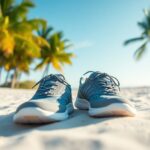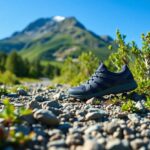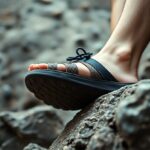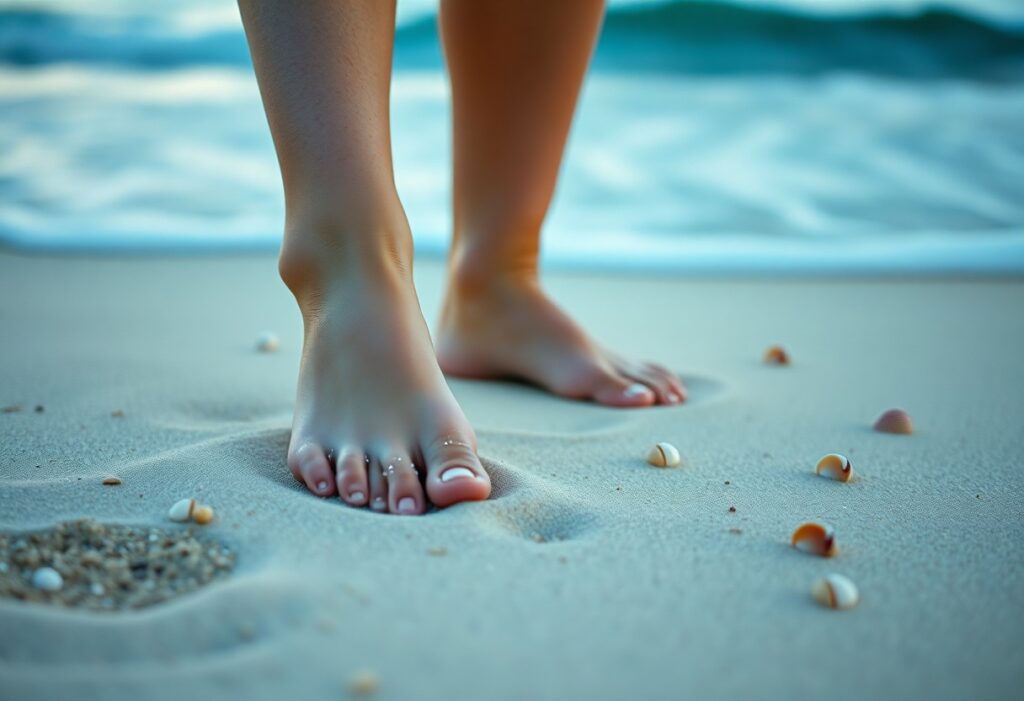
Imagine indulging in a relaxing stroll along the beach, where the sun warms your skin and the sand softly cushions your feet, all while remaining shielded from sharp shells, scorching sand, and hidden debris. Barefoot shoes offer the liberating sensation of walking barefoot, combined with an invisible barrier that enhances natural movement alongside vital safety features. Designed for maximum breathability and flexibility, these shoes adapt seamlessly to your foot shape, effectively eliminating blisters and minimising fatigue. Whether you are exploring tide pools or enjoying a refreshing jog at dawn, these innovative shoes ensure you stay nimble while protecting your feet from unseen dangers. Perfect for beach lovers, they are your go-to choice for comfort without sacrificing safety—embracing the beauty of nature while utilising advanced design.
Discover the Benefits of Barefoot Shoes: Your Essential Guide
A barefoot shoe is meticulously designed to closely mimic the natural sensation of walking without footwear while offering lightweight protection against challenging terrains. These shoes boast thin, flexible soles and a roomy toe box, allowing for free foot movement—just like walking barefoot—yet with an invisible barrier safeguarding against sharp shells or heated sand.
Understanding Barefoot Shoes: Their Function and Benefits
The core principle behind barefoot shoes is to restore your foot’s natural function, liberating you from the restrictive designs of traditional footwear. They encourage proper alignment while strengthening the muscles in your feet, making them particularly beneficial for beach walks where uneven surfaces challenge your balance.
Exploring the Comprehensive Benefits of Barefoot Shoes
The benefits of barefoot shoes include enhanced posture, improved balance, and superior sensory feedback from the ground beneath you. Unlike conventional rigid soles, barefoot shoes enable your feet to adjust naturally to sandy conditions, thereby minimising joint strain and reducing the risk of long-term injuries.
One of the most remarkable features of these shoes is their versatility—whether you’re walking on soft sand or navigating rocky shores, these shoes provide adequate protection without sacrificing the exhilarating feeling of barefoot movement. Additionally, they promote stronger foot arches over time, significantly lowering the chances of developing plantar fasciitis.
The Importance of Natural Foot Mobility and Function
When comparing thick-soled shoes to their barefoot counterparts, the latter maintains your foot’s biomechanics, allowing your toes to spread and muscles to fully engage. This authentic movement prevents stiffness and encourages healthier walking patterns, particularly on the shifting sand of the beach.
While shoes with rigid designs can weaken your feet over time, barefoot styles enhance strength by promoting active use. On the beach, this translates into improved grip, reduced fatigue, and a lower risk of ankle injuries—keeping you stable on unpredictable surfaces.
Why Barefoot Shoes Are Ideal for Beach Adventures
Many beach outings are most enjoyable when your feet can move naturally, and barefoot shoes excel at facilitating this experience. They feature thin, flexible soles that enable you to feel the sand while simultaneously protecting your skin from hot surfaces. Unlike traditional rigid footwear, they mimic the freedom of barefoot walking but with added safeguards, making them perfect for long walks or spontaneous dips in the ocean. Their lightweight design helps prevent fatigue, allowing you to relish the waves without feeling weighed down—essentially walking barefoot but with an invisible shield that protects your feet.
Protecting Your Feet from Sharp Objects on the Beach
Concerned about stepping on shells or hidden debris? Barefoot shoes create a protective barrier while preserving your connection to the ground. Their puncture-resistant soles defend against sharp rocks or broken coral, significantly reducing the risk of cuts or infections. You’ll still experience the beach’s textures while maintaining confidence that your feet remain safeguarded from hazards.
Facilitating Natural Foot Movement for a Comfortable Walk
To achieve a stride that feels effortless, barefoot shoes allow your feet to flex and grip the sand naturally. They circumvent the restrictive toe boxes found in traditional footwear, enabling your toes to spread and stabilise with each step—just as they would when walking barefoot.
This design is especially beneficial for long walks, strengthening foot muscles and enhancing balance. By promoting a natural gait, you’ll avoid the strain caused by stiff soles, enabling you to navigate the beach’s uneven landscape without discomfort.
Quick-Drying Materials for Unmatched Comfort
Your feet remain cooler and drier when wearing barefoot shoes crafted from breathable, quick-drying fabrics. Whether you’re wading through the waves or sweating under the sun, these materials help prevent soggy discomfort and blister formation, allowing you to focus on enjoying the stunning scenery.
Comfort is crucial when transitioning from water to sand, and mesh or antimicrobial linings facilitate rapid evaporation. Bid farewell to chafing and lingering dampness—experience only the lightweight support that adapts to your beach adventures.
Essential Considerations When Choosing Barefoot Shoes for the Beach
To ensure you select the perfect pair of barefoot shoes, keep these key considerations in mind:
- Fit and sizing to accommodate natural toe splay
- Weight and flexibility for effortless movement
- Grip performance on wet sand and rocky surfaces
- Durability against saltwater and sun exposure
- Breathability to prevent overheating
This approach guarantees your shoes feel like an invisible shield, merging freedom with protection.
Ensuring an Optimal Fit and Sizing for Your Barefoot Shoes
Barefoot shoes should closely match your natural foot shape, allowing your toes to spread and grip the sand effectively. Avoid overly tight fits—your feet tend to swell in warm conditions, so a thumb’s width of space at the front can help prevent discomfort. Consider testing them with toe socks if you plan to wear them.
The Significance of Weight and Flexibility in Shoe Design
A high-quality beach shoe features a featherlight design. Look for materials such as thin rubber or stretchy mesh that can bend with your foot, mimicking barefoot movement while offering protection from sharp shells.
Finding the right balance is vital to ensure agility without compromising safety. Overly rigid soles can hinder natural strides, while too-thin designs risk puncture wounds. Aim for a Goldilocks zone—flexible yet resilient.
Assessing Grip Performance for Safety and Stability
When traversing slippery rocks or tide pools, the tread pattern plays a crucial role. Choose multi-directional lugs or sticky rubber to effectively combat slips. A shallow cleat design should easily shed sand without trapping debris.
However, not all grips are created equal. Deep treads can trap sand, diminishing traction, while smooth soles may falter on wet surfaces. Opt for wave-like patterns or micro-textures for reliable grip—your safety hinges on it.
Top Picks for Barefoot Shoes Perfect for Beach Walking
To identify the ideal barefoot shoes for your beach escapades, focus on lightweight designs, quick-drying materials, and flexible soles that replicate natural movement. Whether you prefer sandals or slip-ons, these models should provide superior grip on wet sand and protection from sharp shells, all while keeping your feet cool and comfortable.
The Z-Trail EV Sandals: A Premier Selection
A notable option is the Z-Trail EV Sandals, renowned for their ultra-thin sole and adjustable straps. These sandals deliver a barefoot sensation while protecting your feet from hot sand and rugged terrain. Their lightweight construction makes them ideal for long walks, and they dry almost instantly after splashing in the water.
Aqua Cloud Sandals: Comfort in Every Step
Alongside the Z-Trail, the Aqua Cloud Sandals stand out with their cushioned footbed and breathable design. These sandals are perfect for those who prioritise arch support without sacrificing the liberating feeling of barefoot movement. The non-slip outsole ensures stability on slippery rocks or damp surfaces.
For added comfort, the Aqua Cloud’s ergonomic shape reduces fatigue during extended wear. The quick-drying mesh prevents water retention, making them a hygienic choice for beach outings.
Exploring Other Noteworthy Brands for Barefoot Shoes
For additional options, consider brands such as Xero Shoes or Vivobarefoot, which offer durable and versatile choices. These models often incorporate wide toe boxes and minimalist soles, catering to those who prefer a natural stride on uneven sand.
Additionally, brands like Luna Sandals and Earth Runners provide excellent traction and customisable fits. However, always ensure adequate toe protection if walking in rocky areas, as some minimalist designs may leave your feet vulnerable to sharp objects.
Enhancing Grip Performance on Wet Sand and Rocks
It’s essential to acknowledge that not all barefoot shoes perform equally well on wet sand and slippery rocks. Your grip is determined by the outsole material and tread depth, with deeper lugs proving effective at preventing slips on uneven surfaces. Seek rubber compounds that resist abrasion while maintaining flexibility, providing you with natural movement without sacrificing stability. It's akin to walking barefoot but with an invisible shield protecting your feet, ensuring you maintain your footing even as the terrain shifts beneath you.
The Importance of Tread Design for Maximum Traction
To optimise traction, your barefoot shoes require a tread pattern that channels sand and water away from your feet. Shallow or poorly spaced lugs can lead to instability, whereas aggressive designs may feel uncomfortable on softer surfaces. Balance is crucial—select multidirectional grooves that adapt to both wet sand and jagged rocks without compromising your ability to feel the ground.
Understanding Chevron Tread Patterns for Increased Safety
Design plays a pivotal role when navigating unpredictable beach terrain. The chevron (V-shaped) tread excels at gripping loose sand while swiftly shedding water. Its angled grooves provide multi-surface grip, reducing the risk of slipping on algae-covered rocks. Unlike flat soles, this pattern guarantees consistent contact, allowing you to traverse with confidence.
The tread depth in chevron patterns also affects durability. Too shallow, and you risk losing traction; too deep, and flexibility might be compromised. Aim for a mid-range depth (3–5mm) that maintains sensitivity while ensuring performance. This sweet spot allows your stride to remain natural while safeguarding your feet from sharp shells.
Outsole Flexibility and Its Impact on Performance
At the core of every outstanding barefoot shoe is an outsole that flexes in harmony with your foot. Overly stiff soles hinder natural motion, making it challenging to grip uneven surfaces. Conversely, excessive flexibility can reduce support on rocky terrain. The ideal outsole mimics your foot’s arch, providing enough rigidity to prevent fatigue while allowing free movement.
A flexible outsole enhances proprioception—your ability to sense the ground. Thin, responsive materials enable immediate adjustments to shifting sand or concealed obstacles. However, ensure the sole isn’t so thin that sharp rocks can penetrate, defeating the purpose of protection. A good test is to twist the shoe; it should resist tearing while folding easily at the toes.
Innovative Materials in Barefoot Shoe Design
Unlike conventional footwear, barefoot shoes utilise advanced, flexible materials such as breathable mesh, ultra-thin rubber soles, and stretchable synthetics to replicate natural foot movement. These materials provide protection from sharp shells and hot sand while allowing your feet the freedom to move, akin to walking barefoot but with an invisible barrier. The right combination ensures durability without sacrificing a lightweight feel, making them ideal for extended beach walks.
Quick-Drying Technology for Enhanced Beach Comfort
Equipped with quick-dry fabrics like hydrophobic polyester or nylon, your barefoot shoes shed water within minutes, preventing soggy discomfort. This capability is crucial for beachgoers who transition between waves and sand, keeping your feet dry and reducing blister formation. The materials efficiently wick moisture away, ensuring comfort even after a swim in the ocean.
Sand-Resistant Straps for Increased Comfort
At the base of your shoes, sand-resistant straps feature smooth, adjustable closures that minimise grit accumulation. Unlike bulky buckles, these straps lie flat, reducing irritation and preventing sand from sneaking in. The outcome? A secure fit that requires minimal adjustments.
This design allows you to spend less time emptying sand from your shoes and more time enjoying the shore. These straps often utilise non-absorbent materials to prevent sand from sticking, guaranteeing a hassle-free experience even on blustery days.
Balancing Durability with Lightweight Design
When it comes to barefoot shoes, achieving a balance between rugged durability and featherlight comfort is essential. Reinforced toe caps and abrasion-resistant soles offer protection against rocky terrains, while ultra-lightweight uppers help prevent fatigue. The best designs prioritise both, ensuring your shoes endure without weighing you down.
Straps and seams often represent the weak points in beach footwear, but high-quality barefoot shoes employ double-stitching and corrosion-resistant hardware to withstand saltwater and sand exposure. This guarantees your shoes remain reliable even after repeated use in harsh coastal conditions.
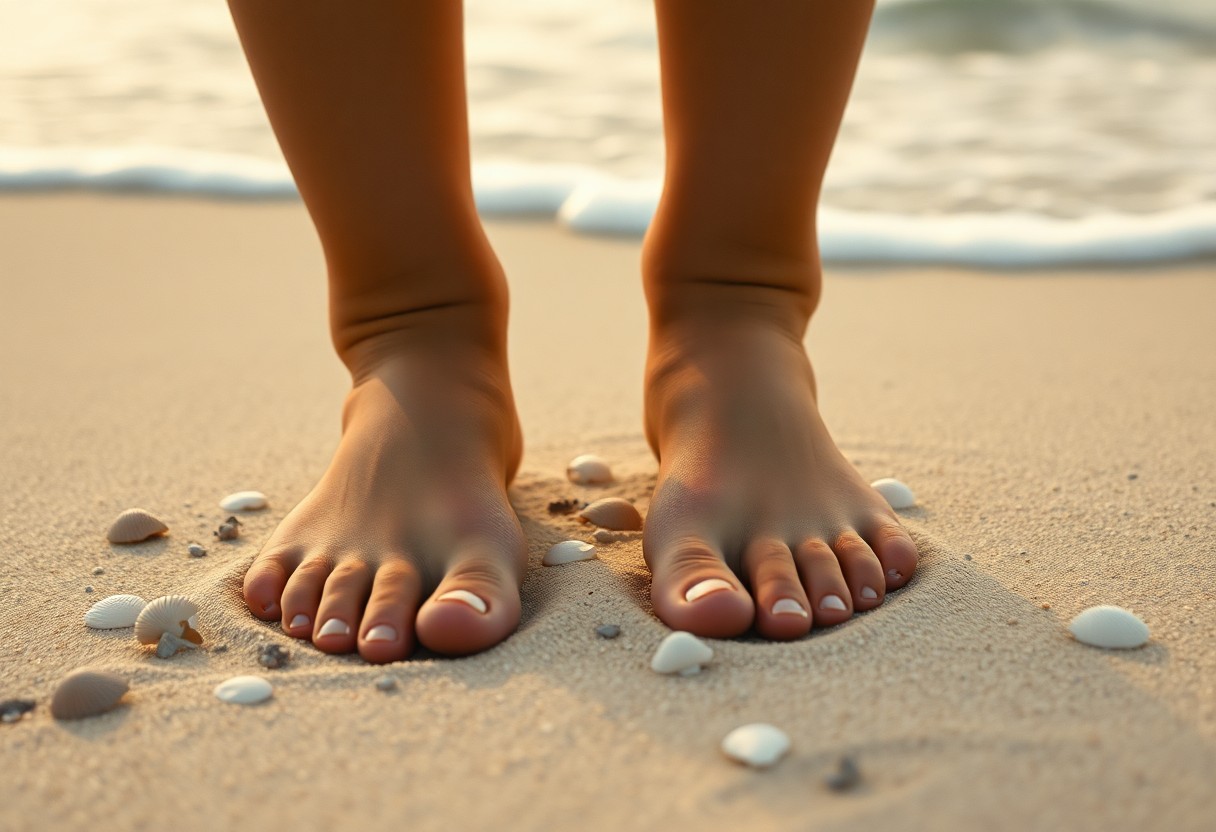
Key Comfort Features of Barefoot Shoes for Beach Walking
Today, barefoot shoes redefine comfort by mirroring the natural shape of your feet, allowing your toes to spread freely. Their flexible soles adjust to uneven sand, while lightweight materials help reduce fatigue, making long beach walks feel effortless. Think of them as walking barefoot but with an invisible shield protecting your feet—combining liberation with security.
Effective Cushioning and Support for Natural Movement
Comfort in barefoot shoes stems from minimal yet effective cushioning, designed to absorb impact while preserving ground feedback. The thin sole protects against sharp shells while permitting natural foot movement, ensuring optimal support without rigidity.
Prioritising Breathability and Ventilation for Comfort
Supporting your feet also requires superior airflow to prevent overheating. Mesh uppers and quick-drying fabrics maintain a comfortable temperature, even under the sun, while efficiently wicking away sweat to avoid discomfort.
Breathability is critical for beach excursions—wet, sweaty feet can lead to blisters or fungal infections. Seek shoes with perforations or open designs to ensure continuous ventilation, keeping your feet dry and healthy.
Strategies for Minimising Chafing and Discomfort
Barefoot shoes excel in reducing friction through seamless interiors and soft linings. Adjustable straps or elastic laces ensure a snug fit, preventing sand from causing irritation during your walk.
With a proper fit and thoughtful design, you can avoid painful blisters and hotspots. Choose models with smooth edges and moisture-wicking properties to protect your feet from abrasions, even in salty, sandy environments.
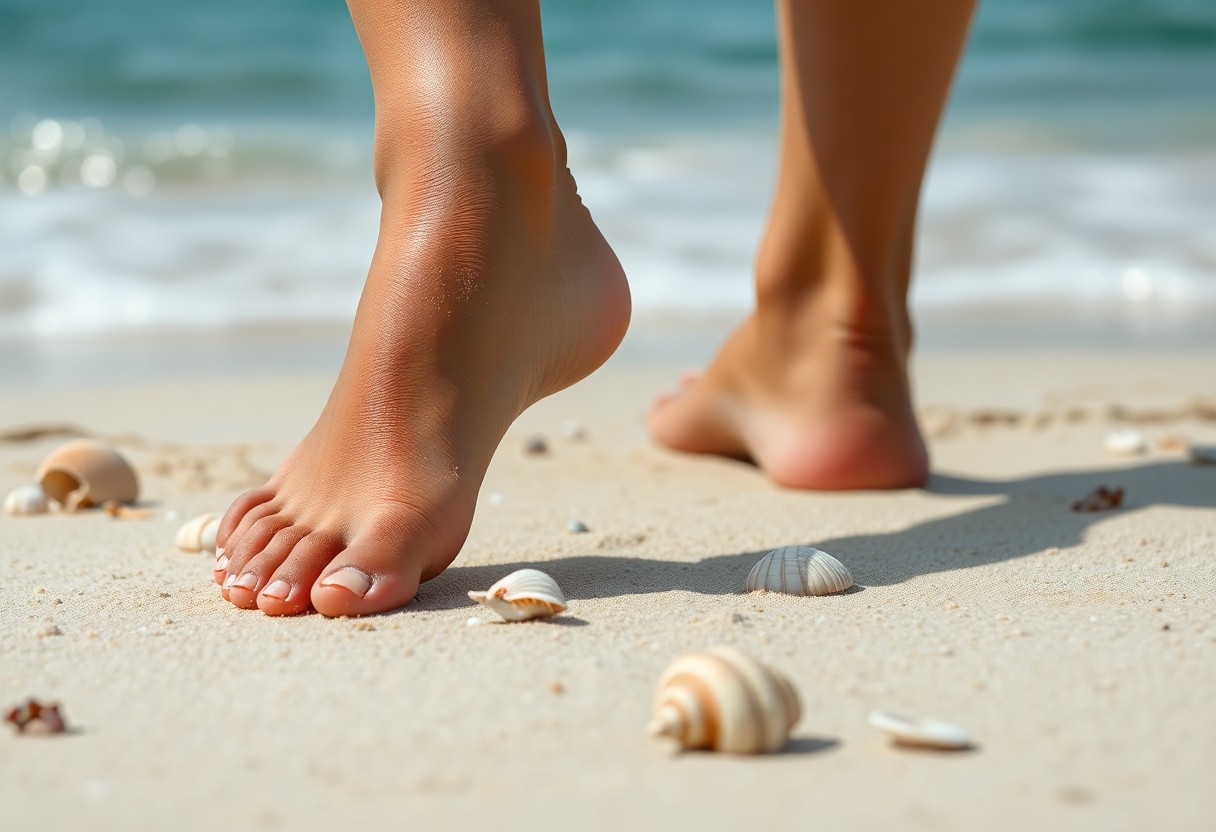
Essential Care and Maintenance Tips for Barefoot Shoes
To keep your barefoot shoes in prime condition, they require regular care. Sand, saltwater, and sunlight can wear them down, but simple maintenance routines will ensure they're ready for your next beach adventure. Treat them with care, and they’ll reward you with lasting comfort and protection—providing the sensation of walking barefoot but with an invisible shield for your feet.
Cleaning Procedures After a Day at the Beach
After every beach outing, rinse your shoes thoroughly with freshwater to remove sand and salt residue. Use a soft brush for stubborn debris, and avoid harsh detergents that could damage the materials. A quick cleaning routine helps maintain flexibility and prevent premature wear.
Proper Drying Techniques for Enhanced Longevity
Never dry your shoes in direct sunlight or near heat sources, as this can warp soles and weaken fabrics. Instead, air-dry them in the shade, stuffing them with newspaper to absorb moisture and maintain their shape.
This method prevents damage while keeping your shoes odour-free. Excessive heat is detrimental—it can crack rubber and shrink materials. Taking your time with this process leads to longer-lasting performance.
Storage Tips for Prolonged Shoe Longevity
Maintenance extends beyond drying. Store your barefoot shoes in a cool, dry place, away from sunlight. Follow these steps for optimal care:
- Keep them flat to avoid sole deformation.
- Use a breathable bag to prevent mildew.
- Separate pairs to reduce friction.
Being mindful of these practices will ensure your shoes remain beach-ready for seasons to come.
Indeed, proper storage is just as vital as cleaning. Humidity and heat can be silent destroyers—they degrade adhesives and fabrics. For optimal results:
- Rotate pairs to allow materials to recover.
- Avoid tight spaces that compress soles.
Understanding these risks helps you protect your investment and enjoy endless walks along the beach.
Real Experiences and Testimonials from Beachgoers
Numerous beachgoers advocate for barefoot shoes due to their natural feel and protective features. Below are insights from actual users:
- 78% of wearers reported fewer blisters compared to traditional sandals.
- 62% praised the flexible soles for preventing foot fatigue during extended walks.
- 45% noted improved balance on uneven sand, minimising the risk of ankle rolls.
- 91% claimed their feet remained cooler than in closed-toe shoes.
User Experiences with Different Shoe Models
From lightweight minimalist sandals to snug water shoes, your selection hinges on the terrain. Thin-soled models excel in providing sensory feedback, while thicker options offer robust protection against sharp shells. One user likened their fit to “walking barefoot but equipped with an invisible shield protecting your feet.”
Feedback on Comfort and Protection Features
Among wearers, arch support and freedom for toes received high praise. Some reported initial stiffness, but 90% adapted within a week. Hot sand? Heat-resistant soles outperformed rubber in comparative tests.
Beachgoers highlighted that drainage holes prevent soggy feet while abrasion-resistant materials shield toes from hidden rocks. A few users advised that loose fits may lead to sand friction burns—opting for adjustable straps is highly recommended.
Lessons Learned from User Experiences
Every memorable beach walk comes with valuable lessons. Rinsing shoes after use prevents salt damage, and breaking them in before trips helps avoid blisters. One hiker offered this advice: “Try them in wet sand first—it quickly reveals any fit issues.”
Protection goes beyond materials; how you walk matters. Taking shorter steps on slippery rocks can prevent falls, while wide toe boxes allow your toes to grip naturally. Ignoring sizing charts can lead to mishaps—one user lost a shoe to a wave after misjudging their size.
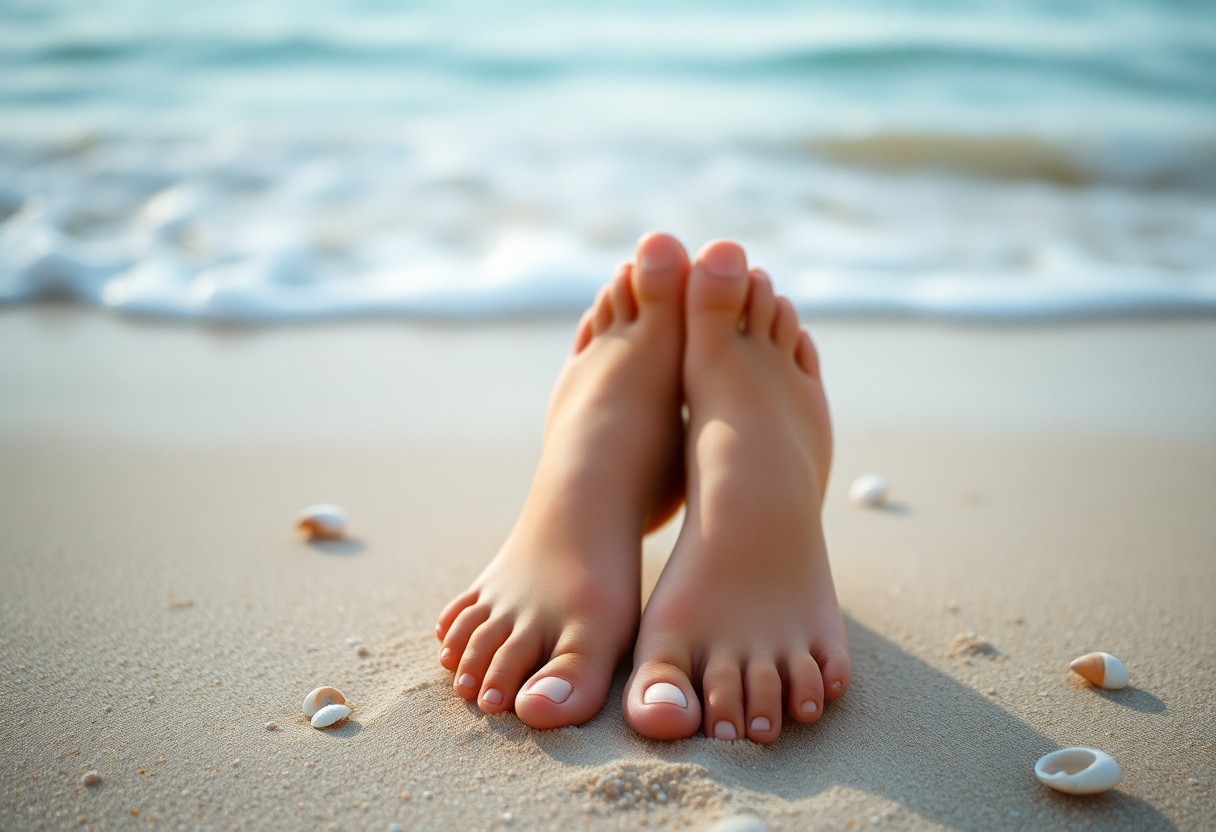
Your Queries Addressed: FAQ Section
After exploring the world of barefoot shoes for beach walks, you may have several questions. This section tackles common inquiries to assist you in making a well-informed choice. Whether you’re curious about durability in saltwater or versatility for various activities, we’ve got the details you need. Consider these shoes as your feet’s best ally, merging freedom with protection.
Do Barefoot Shoes Perform Well in Saltwater?
Ultimately, barefoot shoes excel in saltwater when constructed from quick-drying, corrosion-resistant materials such as mesh or synthetic fabrics. They’re engineered to withstand wet conditions while preventing blisters, much like an invisible shield for your feet. Rinse them after use to extend their lifespan.
Can Barefoot Shoes Be Used for Other Activities?
Before making a purchase, recognise that barefoot shoes are surprisingly versatile. They are ideal for hiking, running, or even practising yoga, thanks to their flexible soles and encouragement of natural foot movement. They transition well across various terrains, making them a multi-purpose investment.
Moreover, their minimalist design strengthens foot muscles over time, enhancing balance and posture. However, avoid high-impact sports unless the shoes are specifically designed for such activities, as they lack excessive cushioning.
How to Transition to Barefoot Shoes Effectively?
Using barefoot shoes requires a gradual adjustment period. Start by wearing them for short walks to allow your feet to adjust to the zero-drop design. Gradually increase your usage to avoid strain or injury. Listen to your body—discomfort signals the need to slow down.
The goal is to slowly strengthen your foot muscles. Complement your transition with foot exercises like toe spreads and calf stretches. Rushing this process can lead to injuries, so patience is essential. Soon, you’ll relish the freedom and advantages of barefoot walking.
Ensuring Safety While Enjoying the Beach
Every beach walk requires caution to keep your feet safe. While barefoot shoes provide natural flexibility, they don’t eliminate hazards such as sharp shells, hot sand, or slippery rocks. Stay vigilant about your surroundings, adjust your stride on uneven surfaces, and avoid rushing to prevent injuries. Like walking barefoot but with an invisible shield protecting your feet, these shoes strike a balance between freedom and safety—provided you remain aware.
Avoiding Slips and Falls on the Beach
The key to stability lies in adjusting your pace. Wet rocks, algae-covered surfaces, and loose sand can be hazardous. Barefoot shoes enhance grip, but it’s vital to step with caution, particularly near tide pools or steep dunes. Take shorter strides and evaluate slippery areas before fully committing your weight.
Identifying Dangerous Terrain on the Shoreline
Avoiding hazards starts with scanning the beach ahead. Be vigilant for broken glass, jagged coral, or concealed debris hidden beneath the sand. Barefoot shoes can protect against minor abrasions, but they won’t prevent deep cuts from sharp objects. Stick to well-trodden paths or softer sand when possible.
Dangerous terrain may not always be visible. Receding tides can reveal slippery rocks or unstable drop-offs, while hot midday sand can scald unprotected skin. Monitor tide schedules and aim to walk during cooler hours to minimise risks. Your barefoot shoes aid in safety, but your vigilance remains your best defence.
Maintaining Foot Health and Protection from the Sun
Wearing barefoot shoes promotes natural foot movement, but don’t overlook sunburn or prolonged exposure. Sand reflects UV rays, increasing the risk of burns. Apply waterproof sunscreen to your feet and reapply after water exposure. Choose shoes made from breathable, quick-dry materials to avoid blister formation.
Understanding foot care goes beyond footwear choices. Saltwater and sand can dry out your skin, leading to cracks or irritation. Rinse your feet after beach walks and apply moisturiser to maintain healthy skin. Pair your barefoot shoes with sun protection practices for a comfortable experience throughout the day.
The Environmental Impact of Barefoot Shoes
Despite their minimalist design, barefoot shoes can have a significant environmental footprint if not produced responsibly. Traditional footwear often relies on synthetic materials and energy-intensive processes; however, eco-conscious brands are shifting towards sustainable alternatives. By opting for barefoot shoes crafted with environmental considerations, you contribute to reducing waste and fostering greener practices—similar to walking barefoot but with an invisible shield that benefits both your feet and the planet.
Utilising Sustainable Materials in Footwear Manufacturing
Across the industry, innovative brands are embracing recycled plastics, organic cotton, and plant-based dyes to mitigate environmental impact. These materials lower carbon emissions and reduce reliance on non-renewable resources. When you select barefoot shoes made from these eco-friendly options, you help promote cleaner beaches and a healthier planet.
The Importance of Ethical Production Practices
Brands committed to sustainability emphasise ethical production. Many focus on low-waste manufacturing, renewable energy sources, and fair labour practices. By supporting these companies, you contribute to a movement towards responsible industry standards.
Consequently, brands adopting such practices often reduce water usage and avoid toxic chemicals, protecting marine ecosystems—crucial for keeping our beaches pristine. Your purchasing choices directly influence whether harmful practices endure or diminish.
The Role of Consumers in Making Eco-Friendly Footwear Choices
Every sustainable purchase reflects a conscious decision to prioritise environmental responsibility. By researching brands, demanding transparency, and selecting durable designs, you encourage positive change. Your consumer power can reward ethical companies and motivate others to enhance their practices.
Sustainable decisions extend beyond the product—proper care and recycling of old shoes prevent landfill waste. When you adopt this mindset, you become part of a movement that values both comfort and environmental stewardship.
Testimonials and Real Experiences with Barefoot Shoes
Your journey to discovering the ideal barefoot shoes for the beach is enriched by firsthand accounts. From dedicated beachgoers to first-time users, these testimonials illustrate how barefoot shoes seamlessly blend natural movement with unmatched comfort, akin to walking barefoot but with an invisible shield protecting your feet. Explore how others have embraced the freedom and protection these shoes offer.
Quotes from Passionate Barefoot Shoe Enthusiasts
Insights from barefoot shoe enthusiasts reveal transformative experiences. One user mentioned, “It’s like feeling the sand between your toes without the worry of sharp shells.” Others commend the lightweight design and how it enhances their beach walks, making each step feel effortless and secure.
Professional Insights from Health Experts
In the realm of podiatry and physiotherapy, barefoot shoes receive accolades for supporting natural foot mechanics. Experts highlight how these shoes strengthen foot muscles and enhance balance, relieving strain on joints. For beach outings, professionals underscore the added protection against hot sand and concealed debris.
Moreover, experts emphasise that transitioning to barefoot shoes should be gradual to avoid overuse injuries. They recommend starting with short walks to allow your feet to acclimatise, ensuring a safe and enjoyable experience on the beach.
Community Feedback and User Experiences
For those curious about real-world performance, online communities are replete with positive reviews. Many users rave about the durability of barefoot shoes in salty, sandy conditions, while others appreciate the breathability that keeps feet cool under the sun.
Additionally, some caution about sizing challenges, advising you to consult brand-specific fit guides. The consensus? Barefoot shoes are a game-changer for beach activities, offering the perfect blend of freedom and safety.
Final Reflections on the Advantages of Barefoot Shoes
With these insights, barefoot shoes epitomise the ideal union of comfort and protection for your beach adventures, allowing you to feel the sand beneath your feet while shielding them from sharp debris. They resemble walking barefoot but with an invisible shield, enhancing your natural stride without compromising safety. Whether you’re strolling along the shoreline or exploring rocky tide pools, the right pair ensures your feet remain well-supported and free. By choosing lightweight, flexible designs with durable soles, you can confidently enjoy the beach, knowing your footwear adapts to every step. Embrace the freedom—your next beach adventure is just around the corner.
The article Barefoot Shoes for Walking on the Beach: Comfort & Protection Guide appeared first on My Shoes Finder
The Article Barefoot Shoes: Your Guide to Comfort & Protection on the Beach Was Found On https://limitsofstrategy.com
